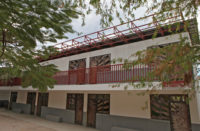Port-au-Prince and Jacmel, Haiti
The massive, 7.0-magnitude earthquake that struck Haiti one year ago, on January 12, killed an estimated 230,000 people and left more than 1.5 million homeless. Thousands of aid groups are working in the distressed island country, but conditions are challenging, and reconstruction is slow going. One organization, however, has managed to make some progress: With the help of architect Jack Ryan, Plan International has built dozens of simple light-frame classrooms that are providing stability and hope for afflicted communities.
Plan, a nonprofit group focused on child development, began working in Haiti in 1973. Today, with 267 employees on the ground, its efforts vary, from training teachers to providing medical care. After the deadly quake, Plan put special focus “on establishing safe spaces for children,” including schools, says Hanna Jamal, education coordinator. “Returning to school gives kids a sense of normalcy,” she notes, “which is really important after a crisis.”
Plan set out to construct 76 semipermanent facilities that would last five to 15 years. The goal was to build them for existing primary schools, both public and private, in Port-au-Prince and Jacmel, a town in the southeast. The locations were chosen in collaboration with the Haitian education ministry.
When attempts to use a local architect fell through, the group reached out to Ryan, a Rhode Island–based architect referred by a Plan employee. Ryan is an associate at 3SIXØ Architecture; when time allows, he does personal projects on the side. Although he has ample construction experience, Ryan had never worked in a developing country or in a post-disaster environment. “I’m not a disaster architect by any means,” he admits. But he was eager to help Haiti and agreed to donate a portion of his services.
Getting started on the design wasn’t easy. “I was a little overwhelmed by the vast approaches people can take,” Ryan says. Then Plan told him he had one week to come up with a scheme, as building materials would be arriving in Haiti at any moment. “Everything went from very vast and open to very focused,” he says.
The materials had been selected in January by engineering consultant Nigel Stuart, who had worked for Plan immediately after the quake. Sensing that shipments to Haiti would be severely delayed, a prescient Stuart had ordered 22 cargo containers full of lumber, tools, nails, hurricane straps, and other material required to construct basic shelters. “At that point, he didn’t have construction documents,” Ryan says. “He just had a napkin sketch.”
Ryan’s design process became an exercise in speed mathematics. He entered the shipping manifesto into a spreadsheet and started to assess how to divvy up the material. Then he reached out to Wilbur Yoder, an engineering friend who had experience building earthquake- and hurricane-resistant structures. He was warned to keep construction methods simple, particularly because local laborers don’t generally work with wood.
In the end, Ryan conceived a 1,000-square-foot single-story box topped by a gabled roof sheathed in a corrugated asphalt material. The load-bearing walls are composed of plywood panels and pine boards. Resembling a brise-soleil, the boards are positioned 0.5 to 3.5 inches apart to provide natural light and ventilation.
Inside, a shear wall cuts the space in half, creating two classrooms, each accommodating 50 students. The interior — furnished with salvaged benches, desks, and chalkboards — is column-free, thanks to a truss system that spans the 24-foot-wide structure. All of the building’s components are measured and cut at a central location and then assembled on-site.
Last April, Ryan traveled to Haiti for the first time to present his plan to the government. He returned in May for three weeks to train local workers and oversee construction of the first buildings. “I was very hands-on with them,” he says, noting that the crew would work from sunrise to sunset. Given that the concrete foundation had been poured one week prior to his arrival, the team was able to complete the first school, in Jacmel, in a little more than a week. Plan has since completed 54 buildings, with 22 more slated for construction.
The classrooms have been well received. “The airflow is great, which is so important in Haiti,” notes Jamal. Ryan continues to work on the project remotely and hopes to return to Haiti at some point. Witnessing the impact such a modest structure can have on a community in need was inspiring, Ryan says. “Children would run up and want to hold our hand and thank us,” he says. “It was really rewarding to be a part of helping rebuild the country.”










Post a comment to this article
Report Abusive Comment